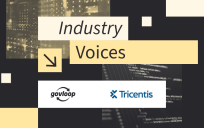The following post is an excerpt from GovLoop’s recent guide, The Top 30 Government Innovations of 2017.
Today, federal agencies are more reliant than ever on IT to accomplish missions and agency business. The current reality is that IT is not merely automating and digitizing processes that were once paper-based and manual – it is actually overhauling how agencies view and execute their missions, which requires powerful IT capabilities that can perform at all levels, at all times.
Much like corporate enterprises that increasingly rely on digital technologies to overhaul their businesses, today’s agencies are also under pressure to reimagine how technology can help advance their missions in far more efficient and innovative ways. To achieve this, agencies must first determine how they invest in modernization initiatives that support future growth and new technologies, while simultaneously leveraging the IT infrastructures they already have. This is not easy because many federal data centers tend to be collections of siloed systems and infrastructures that combine old and current technology.
To discuss these issues, and how next-generation IT infrastructure can help federal government better modernize, GovLoop sat down with Pivot3, a leading provider of hyperconverged infrastructure (HCI) solutions, and gained insights from Jeff Forte, Vice President, Federal Sales and Eric Oberhofer, Federal CTO, Pivot3. They explained why HCI – which tightly integrates storage, compute, network and virtualization resources into a single piece of commodity hardware orchestrated by a software-defined architecture – is an ideal platform for federal IT modernization, and how agencies can leverage Pivot3’s unique technology to consolidate multiple, mixed application workloads on a single platform, while also integrating with existing infrastructures and IT investments.
In addition to unifying fragmented infrastructures, HCI also orchestrates them to be far more efficient from a resource perspective, which provides easy-to-scale, easy-to-operate modernization solutions.
HCI solutions have been successfully applied to a targeted set of standalone workloads such as virtual desktop infrastructure (VDI), web farms and data protection. The current generation of HCIs, however, has not seen much adoption as a core data center platform supporting a diverse mix of consolidated workloads. Forte explains, “The current generation of HCIs lack the ability to guarantee performance levels to varying tiers of workloads, making it very complex to consolidate workloads onto a single platform.” Moreover, Oberhofer emphasized that a lack of high-end performance was also a limitation of some HCIs in the datacenter.
Pivot3 recognized these shortcomings of current generation HCIs and purpose-built its Acuity HCI platform to overcome those limitations, positioning it as a core data center platform.
Pivot3 Acuity is the industry’s first and only hyperconverged software platform that combines the performance of NVMe PCIe flash and the simplicity of advanced, policy-based QoS, along with a comprehensive set of data services such as patented erasure coding, to expand the possibilities of what businesses can do with HCI. Now Agencies can confidently consolidate a broader set of workloads on to a single infrastructure platform and deliver guaranteed performance to the applications that drive their missions. Acuity’s architecture also efficiently manages multiple storage tiers ensuring Pivot3’s systems can be used as the foundation for agencies that want to use hyperconverged as a consolidation platform for multiple workloads with mixed I/O profiles, according to IDC.
Additionally, Acuity doesn’t require datacenter managers to refresh all their technology at once. Many agencies will still have applications and programs that have their own infrastructure, and will need to co-exist with a converged environment. As such, Pivot3 enables agencies to start with what only what they need, with the ability to scale compute and storage independently to meet specific application requirements as their environment grows. The result is a modular approach to IT infrastructure that offers an ideal mix of performance, capacity, flexibility and price.
The same positive outcomes agencies are able to realize from HCI in areas like virtual desktops, shared storage, and workload consolidation can help them in meeting many IT modernization goals, like scalability, availability, performance, security, cost, and efficiency. As HCI evolves with more next-generation capabilities, these benefits become even stronger, making Pivot3 HCI well-positioned to handle the use cases that move agencies toward modern technology solutions that not only reduce the cost and complexity of traditional IT environments, but also act as a natural extension of the data center into the cloud.
For federal agencies seeking to confront tightened budgets while keeping pace with the rapid rate of technological innovation in 2018 and the years to come, Pivot3’s next-generation hyperconvergence is the smart path forward.
Read the full Top 30 Innovations of 2017 guide, here.






Leave a Reply
You must be logged in to post a comment.